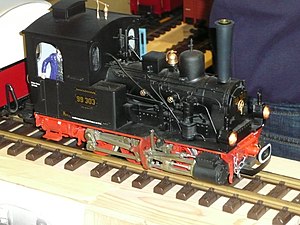Mecklenburg T 7
| Mecklenburg T 7 DR class 99.30 |
|
|---|---|
|
model
|
|
| Numbering: | No. 1005-1007 99 301-303 |
| Number: | 3 |
| Manufacturer: | Henschel |
| Year of construction (s): | 1910-14 |
| Retirement: | 1948 |
| Type : | C n2t |
| Genre : | K.33.6 |
| Gauge : | 900 mm |
| Length over buffers: | 5,650 mm |
| Height: | 3,330 mm 3,480 mm (No. 1007) |
| Total wheelbase: | 1,800 mm |
| Empty mass: | 13.0-13.6 t |
| Service mass: | 16.0-16.2 t |
| Friction mass: | 16.0-16.2 t |
| Wheel set mass : | 5.4 t |
| Top speed: | 30 km / h |
| Indexed performance : | 125 PS / 92 kW |
| Starting tractive effort: | 22.95 kN |
| Coupling wheel diameter: | 700 mm |
| Control type : | Stephenson |
| Number of cylinders: | 2 |
| Cylinder diameter: | 260 mm |
| Piston stroke: | 400 mm |
| Boiler overpressure: | 12 bar |
| Number of heating pipes: | 98 |
| Heating pipe length: | 2200 mm |
| Grate area: | 0.56 m² |
| Radiant heating surface: | 2.64 m² 3.09 m² (No. 1007) |
| Tubular heating surface: | 27.41 m² |
| Evaporation heating surface: | 30.05 m² 30.50 m² (No. 1007) |
| Water supply: | 1.7 m³ |
| Fuel supply: | 0.75 tons of coal |
| Brake: | Hand brake, Knorr air brake |
The vehicles of type T 7 of the Grand Ducal Mecklenburg Friedrich-Franz-Eisenbahn were three-axle narrow-gauge locomotives. They were used on the bath railway between Bad Doberan and Kühlungsborn . At the Deutsche Reichsbahn they were classified in the class 99.30 .
history
With the extension of the line of the Bäderbahn to Arendsee and the simultaneous start of freight traffic, additional traction vehicles were required. The Friedrich-Franz-Eisenbahn therefore ordered a locomotive from Henschel that largely corresponded to the previous class XIX machines . Two more locomotives followed in 1911 and 1914. They replaced the XIX in operational service on the Bäderbahn. The locomotives were in service with the Bäderbahn until 1923/1924 and were then replaced by the class 99.31 locomotives . As a result, machines 99 301 and 99 303 were transferred to the Neubukow beet railway . They were in service there until 1946 and were transported to the Soviet Union as reparations in April 1948. The 99 302 was stationed as a reserve locomotive in Bad Doberan until 1932 and was then retired.
Constructive features
The frame, made of riveted nine millimeter thick sheet metal, was designed as a water tank. The riveted long shell consisted of two shots. The steam dome was on the front shot, the sandpit on the second, and the Ramsbottom safety valves on the top of the standing boiler in front of the cab. The boiler was fed by two suction steam jet pumps.
The external, horizontally arranged two-cylinder wet steam engine worked on the rearmost coupled axle. The Stephenson control with flat slides was external. The engine was clad until the mid-1920s.
The drive was supported at four points. The two foremost wheel sets had overhead leaf springs. These were connected by compensating levers. The rear axle had leaf springs under the axle bearings.
The locomotives had a two-chamber air brake that braked the first and third wheel sets from the outside. The machines also had a throw lever handbrake.
The hand-operated sand spreader sanded the outer wheelset from the outside. The machines also had steam heating and kerosene lighting. The coal was housed in small bins on the left and right in front of the driver's cab.
literature
- Hans-Joachim Kirsche, Hermann Lohr, Georg Thielmann: Lokomotiv-Archiv Mecklenburg / Oldenburg . transpress, Berlin 1989, ISBN 3-344-00326-7 .
- Manfred Weisbrod, Hans Wiegard, Hans Müller, Wolfgang Petznick: German Locomotive Archive: Steam Locomotives 4 (Class 99) . transpress, Berlin 1995, ISBN 3-344-70903-8 .
